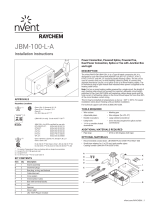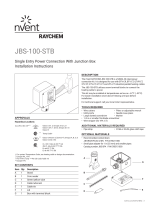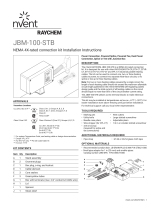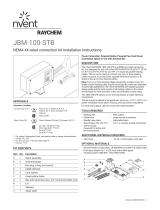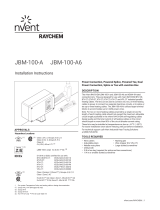Page is loading ...

DESCRIPTION
The nVent RAYCHEM E-100-L is a NEMA 4X-rated end seal kit with a
light that indicates voltage at the end of the circuit. It is designed for use
with RAYCHEM BTV-CR, BTV-CT, QTVR-CT, XTV-CT, KTV-CT, and VPL-CT
industrial parallel heating cables. Once installed, the end seal is easily
re-entered for maintenance and the heating cable can be accessed
without removing the end seal. The LED indicator light provides excellent
visibility.
This kit may be installed at temperatures as low as –40°F (–40°C).
For easier installation store above freezing until just before
installation.
Two units are available:
– E-100-L1 for 100–120 volts.
– E-100-L2 for 200–277 volts.
Make sure voltage rating of light is the same as that of the
heat-tracing circuit.
For technical support call nVent at (800)545-6258.
TOOLS REQUIRED
• Wire cutters • Utility knife
• Needle nose pliers • Slotted screwdriver or nutdriver
• Panduit CT-100 crimp tool or equivalent
ADDITIONAL MATERIALS REQUIRED
• Pipe strap • GT-66 or GS-54 glass cloth tape
OPTIONAL MATERIALS
• Small pipe adapter for 1 in (25 mm) and smaller pipes:
Catalog number JBS-SPA P/N E90515-000
KIT CONTENTS
Item Qty Description
A 1 End seal and light assembly
B 2 Insulated parallel crimps (blue)
C 1 End seal label
D 1 Cable lubricant
E 1 Cable tie
F 1 Core sealer
B
D
C
E
Stand
A
F
Strain
relief
Leash
Light
APPROVALS
CLI, ZN1, AEx em II T*
(1)
Ex em II T*
Hazardous Locations
(1)
Except VPL
* For system Temperature Code, see heating cable or design documentation
.
(2)
Except KTV-CT
Class I, Div. 2, Groups A, B, C, D
Class II, Div. 2, Groups E, F, G
Class III
E-100-L is IECEx certified for use with:
BTV-CR/BTV-CT: IECEx BAS 06.0043X
QTVR-CT: IECEx BAS 06.0045X
XTV-CT: IECEx BAS 06.0044X
KTV-CT: IECEx BAS 06.0046X
VPL-CT: IECEx BAS 06.0048X
– WS
Ex em IIC T* Gb
(2)
IECEx
E-100-L
High-Profile End Seal With Light Installation Instructions

2 | nVent.com
24 in
(60 cm)
12 in
(30 cm)
45°
Indentation (bus wire
connection on VPL
heating cables only).
12 in
(30 cm)
Drain hole
1 2
• Allow approximately 24 in (60 cm) of heating cable for
installation. For VPL, cut cable 12 in (30 cm) from bus
indentation.
• Cut off heating cable end at about 45° for easier
insertion.
• Apply lubricant for easier
insertion into stand.
• Optional: If stand is to be
installed on bottom side
of pipe, knock out drain
hole prior to inserting
cable.
• Slide heating cable
through stand.
• Square off cable end with
90° cut.
Inner jacket
Braid
Outer
jacket
Spacer
Conductive fiber
XTV-CT, KTV-CT
Bus wire
BTV-CR, BTV-CT, QTVR-CT
Bus wire
Conductive core
Inner jacket
Braid
Outer
jacket
Clear jacket
Inner jacket
Braid
Outer
jacket
Heating element
Insulated bus wire
Bus wire connection
VPL-CT
Heating Cable Types
This component is an electrical device that must be
installed correctly to ensure proper operation and to
prevent shock or fire. Read these important warnings
and carefully follow all of the installation instructions.
• To minimize the danger of fire from sustained
electrical arcing if the heating cable is damaged
or improperly installed, and to comply with the
requirements of nVent, agency certifications, and
national electrical codes, ground-fault equipment
protection must be used. Arcing may not be stopped
by conventional circuit breakers.
• Component approvals and performance are based
on the use of nVent-specified parts only. Do not
use substitute parts or vinyl electrical tape.
• The black heating cable core and fibers are
conductive and can short. They must be properly
insulated and kept dry.
• Damaged bus wires can overheat or short. Do not
break bus wire strands when scoring the jacket or
core.
• Keep components and heating cable ends dry
before and during installation.
• Bus wires will short if they contact each other.
Keep bus wires separated.
• Use only fire-resistant insulation materials, such
as fiberglass wrap or flame-retardant foam.
• Leave these installation instructions with the user
for future use.
HEALTH HAZARD: Prolonged or repeated contact
with the sealant in the core sealer may cause skin
irritation. Wash hands thoroughly. Overheating or
burning the sealant will produce fumes that may
cause polymer fume fever. Avoid contamination of
cigarettes or tobacco. Consult MSDS VEN0033 for
further information.
CHEMTREC 24-hour emergency telephone:
(800) 424-9300.
Non-emergency health and safety information:
(800) 545-6258.
WARNING:
CAUTION:

nVent.com | 3
2 1/4 in
(57 mm)
3
• Measure exactly 2 1/4 in (57 mm).
• Lightly score outer jacket around and
down as shown.
• Bend heating cable to break jacket at
score; peel off jacket.
• Remove all exposed braid.
XTV, KTV
BTV, QTVR
Go to Step 5A
Go to Step 5B
Go to Step 5C
VPL
4
• Determine heating cable type and continue as shown.
XTV, KTV
1 3/8 in
(35 mm)
Do not cut bus wires
• Measure exactly
1 3/8 in (35 mm).
• Lightly score inner
jacket around and
down as shown.
• Peel off jacket.
• Cut and remove all
fiber strands.
• Score and remove
center spacer.
• Remove any
remaining fiber
material from bus
wires.
Go to Step 6
5A

4 | nVent.com
1 3/8 in
(35 mm)
1/2 in
(13 mm)
Do not cut bus wires
VPL
5C
• Measure exactly
1 3/8 in (35 mm).
• Lightly score inner
jacket around and
down as shown.
• Peel off inner jacket.
• Unwind heating
element, cut and
remove as shown.
• Lightly score clear
jacket around and
down as shown.
• Remove insulation
from ends of bus
wires.
Go to Step 6
1/4 in
(5 mm)
1 3/8 in
(35 mm)
Do not cut bus wires
BTV, QTVR
5B
• Measure exactly
1 3/8 in (35 mm).
• Lightly score inner
jacket around and
down as shown.
• Peel off jacket.
• Notch core.
• Peel bus wire from core.
• Score core between bus
wires at inner jacket.
• Bend and snap core.
• Peel core from bus wire.
• Remove any remaining core
material from bus wires.
Go to Step 6

nVent.com | 5
Make sure the bus
wires do not kink,
bunch, or crossover.
8
9
• Push core sealer onto the heating
cable to the mark made in step 6.
Note: Extra force may be required
for larger cables or at lower
temperatures.
• Remove the guide tubes and
dispose of them in a plastic bag.
1 3/4 in
(44 mm)
Strain
relief
Braid
10
• Pull cable back through end seal stand until braid is just
visible above strain relief.
1/2 in
(13 mm)
11
• Trim exposed
conductors.
5/8 in
(15 mm)
6
• Mark the jacket
as shown.
Tubes
Make sure all strands
go into the tubes.
7
• If needed, re-twist and straighten
bus wires, then insert bus wires
into guide tubes as shown.
Caution: Health Hazard. Wash hands after contact
with sealant. Consult material safety data sheet
VEN0033.

6 | nVent.com
Note: For 1 in
(25-mm) and smaller
pipes use adapter
(purchased
separately) between
stand and pipe.
Position
adapter this
side up.
JBS-SPA
adapter for
small pipes
• Fasten end seal stand to pipe with pipe strap. Do not pinch
heating cable. Be sure pipe strap is under heating cable.
• Loop and tape extra heating cable to pipe. Minimum bend
radius is 3/4 in (20 mm).
12
Insulated
parallel
crimps
13
• Place blue crimps
onto bus wires.
• Crimp bus wires to
lead wires.
Be sure wires
are not caught
in threads.
14
• Push excess wire
inside light.
• Tighten light onto end seal stand.

nVent.com | 7
Trim
Weather seal
15
16
• Insert cable tie through the slot on stand and the slot on
the light, then tighten.
• Apply insulation and weather-seal the stand entry.
• Fasten end seal label to insulation.
• Leave these instructions with the end user for future
reference.

nVent.com
©2018 nVent. All nVent marks and logos are owned or licensed by nVent Services GmbH or its aliates. All other trademarks are the property of their respective owners.
nVent reserves the right to change specications without notice.
Raychem-IM-H55923-E100Lendseal-EN-1805 PN 863747-000
North America
Tel +1.800.545.6258
Fax +1.800.527.5703
Europe, Middle East, Africa
Tel +32.16.213.511
Fax +32.16.213.604
Asia Pacific
Tel +86.21.2412.1688
Fax +86.21.5426.3167
Latin America
Tel +1.713.868.4800
Fax +1.713.868.2333
Troubleshooting Guide
Problem Troubleshooting steps
Light is dim
or off.
1. Check that light voltage rating matches supply voltage for heat-tracing circuit. Supply voltage lower or higher than light rating
will cause malfunctions.
2. Check that heat-tracing circuit is energized. Although the circuit breaker is on, control devices such as thermostats may switch
heating cable off.
3. Following electrical safety procedures, disconnect supply voltage, unscrew light from end seal base and check that crimp
connections to heating cable bus wires are tight and not crossed or shorted. Loose connections or shorts will cause malfunctions.
4. With circuit off, attach volt meter leads to crimps. Energize circuit and measure voltage at light. Use the following table to
determine whether the voltage measured is within the acceptable range.
Catalog name Nominal voltage Acceptable voltage range
E-100-L1 100–120 Vac 58–132 Vac
E-100-L2 200–277 Vac 145–305 Vac
• If voltage at light is in acceptable range and connections are good, the light may be defective or damaged. Replace light.
• If there is no voltage at the light, there may be breaks in the heating cable between the power connection and the end seal.
Check for splice or tee connections that may be left open.
• If voltage at light is above specified limits, the light may be off. Voltages above specified range can damage light. Replace light
with correct version for line supply voltage or adjust supply voltage accordingly.
• If voltage at light is present but below specified limits, the light may be dim or off. The following table lists typical causes for
low voltages and possible solutions.
Cause Solution
Supply voltage at start of circuit is low (light is designed
to work with supply voltages within 10% of nominal).
Increase power wire gauge size to reduce voltage drop
between panel and heating cable power connection.
Heating cable length is too long (light is designed to
work with published maximum circuit lengths).
Split heating cable into multiple circuits. Shorten length of
heating cable.
Heating cable is started under very cold conditions
(heating-cable voltage drop is very high for first minutes
of very cold start-up).
Wait for heating cable to warm up. Voltage at light will
increase.
Heating cable controller is reducing voltage (light may
not work with controllers that phase fire to reduce line
voltage).
Turn off phase firing function in heating cable controller.
Problem Troubleshooting steps
Cap cannot be
tightened
completely.
1. Check that heating cable is installed and stripped correctly. The top of the insulated parallel crimps should be 2 3/8 in (60 mm),
or less, above the top of the plastic strain relief in the stand.
2. Check that core sealer is positioned properly. The end of the core sealer must be flush against the plastic strain relief in
the stand.
3. Check that the threads on the light and stand are clean. The connection wires between the heating cable and the light should
not be caught in stand threads.
/
